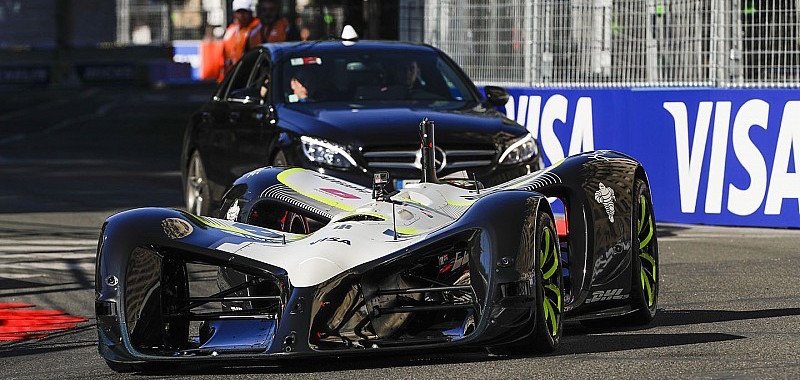Roborace explained: Where artificial intelligence meets racing

Roborace is set to organise the first championship for self-driving vehicles, or 'AI drivers' as the organisation prefers to name it. The competition will take place at street tracks currently used by Formula E.
Today, Roborace has built three Devbot development cars and soon hopes to have three Robocars available. The company aims to build a platform to showcase autonomous technology and where it can advance.
It takes a similar approach as Formula E currently does with electric formula cars, where road relevant technology is being developed. But the two championships differ from each other in approach. At Roborace, the development of software will be key while in Formula E some modifications to the hardware can be made.
"Roborace is the future of connected and autonomous technology which is coming into the road cars in three, five or ten years' time, depending on the horizons," explained Bryn Balcombe, chief technical officer at Roborace, to Motorsport.com.
"We are using motorsports as an acceleration of all that technology. Which is what motorsports has been in the past and to some extent is now. We are developing road relevant technology."
Software 'brain' replaces driver
Without a physical driver, success on track mainly comes down to a team's software developers. They will be helped by information from the car's multiple sensors, radars and cameras that feed 'the brain' that in the end should make the decisions.
The hardware, like the powertrain, aerodynamics, chassis and the tyres, is equal to every team. The Robocar will always make use of the best available equipment on the market, where price doesn't seem to be an issue.
"You have the eyes, the ears and the brain," said Balcombe. "Perhaps a big brain, but that's irrelevant if you don't have the intelligence to use those sensors and processing power to make the decisions. And that's what the teams do, so that middle ground is also where we want to advance technology.
"We'll always be using the best sensors and the best computer on this platform and we'll integrate that with our partners as we have done with Nvidia at the moment. We don't have to wait until the price point of the sensors or the computer is at volume manufacturing level. So, we would always be in advance of the road industry."
"AI drivers are the stars of the future"
When the core task of the teams is to focus on the AI driver development, the question remains how to make a competition with state-of-the-art technology – and no physical drivers – attractive to watch. Balcombe isn't worried as the decisions can be communicated with the public in real time.
"The AI drivers are really the characters and stars of the future," he explained. "There is always the [artificial] driver inside the car, responsible for the perception, the reasoning and the action.
"Should I overtake this car or not, should I go down the inside, will the other car respond in the way I expect him to respond? What's the chance I will miss the apex of the corner or what are the chances that he closes in on me and we have contact? All of that is the reasoning of the driver and that's something that we can bring to the public through the software.
"So, we are able to interrogate the driver real time asking him to publish what he believes the state of the environment is, what risks he thinks he's taking, what he sees the other drivers are going to do. We can communicate that in real time to the public."
Level-five autonomous competition
It has yet to be determined exactly what the competition will look like. It is possible that the cars will hit the track racing each other side by side, as seen in most other championships, but Balcombe reckoned that the development of the technology might require different challenges and operational domains.
But the technology needs to advance first, giving the example that the Robocar of today could not replicate Max Verstappen's phenomenal drive in Brazil 2016 when the Red Bull driver exactly knew which racing lines would provide most grip.
"We've looked at what a level-five autonomous competition needs to be," he said. "The industry is moving towards level-five autonomy. The only differentiation between level four and five is the amount of domains you can operate in, meaning that it must be able to race at night, at different types of circuits and under different weather conditions.
"What you are missing from that is other obstacles that are on the track. If it becomes a lap time optimisation, like most motorsports categories, it comes down to managing your energy and tyres. That's not particularly road relevant in terms of technology development.
"So, we are focusing on other things that would introduce road relevance and that becomes traffic. If you have other dynamic obstacles at the track, it makes it much more challenging for a driver.
"Take Le Mans: that can be more challenging than Formula 1 when you have to pass traffic because they are doing significantly different speed than you. That is another skill as a driver."
Potential participants
While showcasing the Devbots and Robocars at the Formula E tracks, Roborace received interest from up to 200 companies that like the concept of an autonomous racing championship with the goal of advancing technology.
The list of potential participants includes a very diverse mix of car manufacturers, mobility providers, motorsports teams, universities and PHD-level research platforms.
The first competition is set to take place when Formula E enters Season 4 in December.
Related News
